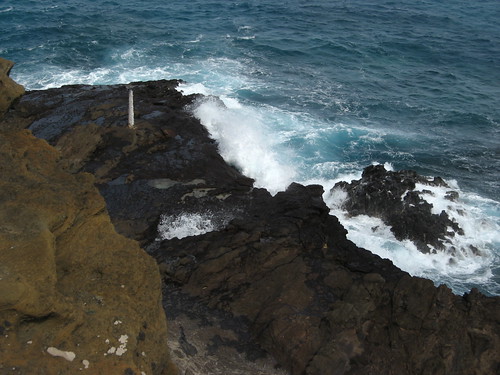ńĀöń®ČķĪ»ńż║’╝īÕż¬Õ╣│µ┤ŗõ┐Īķó©ńÜäĶ«ŖÕī¢Ķʤ20õĖ¢ń┤ĆńÜäµ░ŻÕĆÖĶ«ŖÕī¢µü»µü»ńøĖķŚ£’╝īÕøĀµŁżÕÅ»ĶāĮÕĮ▒ķ¤┐µ£¬õŠåńÜäÕģ©ńÉāµ░Żµ║½ŃĆé
µÜ¢Õī¢ńĘ®µŁźµÅŁĶ¼ÄÕ║Ģ ńå▒ÕĖČÕ╝Ęķ󩵜»ķŚ£ķŹĄ
ńŠÄÕ£ŗÕ£ŗÕ«ČÕż¦µ░ŻńĀöń®ČõĖŁÕ┐ā’╝łNCAR’╝ēÕÆīõ║×µŁĘµĪæń┤ŹÕż¦ÕŁĖńÜäń¦æÕŁĖÕ«ČõĮ┐ńö©õĖĆń©«µ¢░ńÜäµĖ¼ķćŵ¢╣µ│Ģ’╝īÕłåµ×ÉńÅŖńæÜńÜäÕī¢ÕŁĖĶ«ŖÕī¢ÕŠīńÖ╝ńÅŠ’╝īńå▒ÕĖČÕż¬Õ╣│µ┤ŗõ┐Īķó©ńÜäĶĮēÕ╝▒’╝īÕÆī20õĖ¢ń┤ƵŚ®µ£¤ńÜäÕģ©ńÉāµÜ¢Õī¢µ║½Õ║”µ£ēµēĆķŚ£Ķü»ŃĆé
ŃĆīńå▒ÕĖČÕż¬Õ╣│µ┤ŗÕ╝Ęķó©ķüÄÕÄ╗15Õ╣┤ķ¢ōµē«µ╝öµĖøńĘ®µÜ¢Õī¢ńÜäķćŹĶ”üĶ¦ÆĶē▓ŃĆéńĢČķó©µĖøÕ╝▒’╝īµÜ¢Õī¢Õ░▒µ£āķ¢ŗÕ¦ŗÕŖĀķƤŃĆéŃĆŹńĀöń®ČõĖ╗Ķ”üõĮ£ĶĆģŃĆüNCARÕŹÜÕŻ½ÕŠīń¦æÕŁĖÕ«ČDiane ThompsonĶ¬¬ŃĆé
ÕŹ│õĮ┐Õģ©ńÉāµīüń║īµÄƵöŠõ║īµ░¦Õī¢ńó│ÕÆīÕģČõ╗¢µ║½Õ«żµ░Żķ½ö’╝īńĀöń®ČńĄÉµ×£õ╗ŹķĪ»ńż║’╝īŃĆīÕż¬Õ╣│µ┤ŗõ┐Īķó©Ķ«ŖÕ╝ĘĶ«ōÕģ©ńÉāµÜ¢Õī¢ĶČ©ńĘ®ŃĆŹńÜäńÉåĶ½¢ńŹ▓ÕŠŚµö»µīüŃĆé
ThompsonÕ£śķÜŖńÜäńĀöń®ČµīćÕć║ķĆÖµ©ŻńÜäķüÄń©ŗķüÄÕÄ╗Õ░▒µøŠńÖ╝ńö¤’╝īõ╣¤ÕÅ»ĶāĮõ╗źńøĖÕÅŹńÜäµ¢╣Õ╝ÅńÖ╝ńö¤ŌöĆŌöĆķó©µĖøÕ╝▒ŃĆüµÜ¢Õī¢ÕŖĀķƤŃĆéõĮ£ĶĆģµīćÕć║’╝īńĢČÕż¬Õ╣│µ┤ŗõ┐Īķó©ÕøĀĶć¬ńäČķĆ▒µ£¤µö╣Ķ«Ŗ’╝īµÜ¢Õī¢Õ░▒µ£āÕåŹÕ║”ķ¢ŗÕ¦ŗŃĆé
ŃĆīµłæÕĆæµŁŻĶ®”ĶæŚńףĶ¦ŻĶć¬ńäČĶ«ŖÕī¢ńÜäĶ”ÅÕŠŗ’╝īĶ«ōń¦æÕŁĖÕ«Čµø┤ĶāĮķĀɵĖ¼µ£¬õŠåµ░ŻÕĆÖĶ«ŖķüĘńÜäĶĄ░ÕÉæŃĆéŃĆŹÕģ▒ÕÉīõĮ£ĶĆģŃĆüõ║×µŁĘµĪæń┤ŹÕż¦ÕŁĖµĢֵijJulia ColeĶ¬¬ŃĆé
ńĀöń®Čµ£¼Õæ©ńÖ╝ĶĪ©µ¢╝ŃĆŖĶć¬ńäČÕ£░ńÉāń¦æÕŁĖŃĆŗµ£¤ÕłŖ’╝īńö▒Õ£ŗÕ«Čń¦æÕŁĖÕ¤║ķćæµ£āŃĆüÕ£ŗÕ«ČµĄĘµ┤ŗÕż¦µ░Żń«ĪńÉåÕ▒ĆŃĆüõ║×µŁĘµĪæń┤ŹÕż¦ÕŁĖŃĆüµģłÕ¢äµĢÖĶé▓µ®¤µ¦ŗŃĆüĶŗ▒Õ£ŗĶć¬ńäČńÆ░ÕóāńĀöń®ČÕ¦öÕōĪµ£āÕÆīńŠÄÕ£ŗĶāĮµ║Éķā©Ķ│ćÕŖ®ŃĆé
µČłÕż▒ńÜäńå▒ĶāĮ Ķć¬ńäČńĢīĶć¬ÕŗĢµÄ¦µ║½
2001Õ╣┤ĶĄĘ’╝īÕŹ│õĮ┐µ║½Õ«żµ░Żķ½öÕó×ÕŖĀ’╝īÕģ©ńÉāĶĪ©ķØóµ║½Õ║”õĖ”µ▓Ƶ£ēµśÄķĪ»õĖŖÕŹćŃĆéķĆÖÕĆŗÕģ©ńÉāµÜ¢Õī¢Õü£µ╗»ńÜäńÅŠĶ▒ĪÕ╝ĢĶĄĘĶ©▒ÕżÜµ░ŻÕĆÖń¦æÕŁĖÕ«Čµ│©µäÅ’╝īĶ®”Õ£¢Õ░ŗµēŠµČłÕż▒ńÜäńå▒ĶāĮŃĆé
ń¦æÕŁĖÕ«Čńö©µ░ŻÕĆÖµ©ĪÕ×ŗÕÆīĶ¦ĆÕ»¤ńÖ╝ńÅŠ’╝īńå▒ÕÅ»ĶāĮÕøĀńé║Õż¦µ░ŻÕŠ¬ńÆ░ńÜäķŚ£õ┐éķĆ▓Õģźõ║åµĄĘµ┤ŗŃĆéķĆÖĶ«ōÕż¦µ░ŻõĖŁńÜäńå▒ĶāĮµĖøÕ░æ’╝īµÜ½µÖéµŖĄµČłõ║åµ║½Õ«żµ░Żķ½öķĆĀµłÉńÜäµÜ¢Õī¢µĢłµćēŃĆé
õ╗ŖÕ╣┤ń©ŹµŚ®’╝īõĖĆńĄäÕ£ŗķÜøµ░ŻÕĆÖń¦æÕŁĖÕ«ČÕ£śķÜŖńÖ╝ĶĪ©ńĀöń®Čµ¢╝µ¢╝ŃĆŖĶć¬ńäȵ░ŻÕĆÖĶ«ŖÕī¢ŃĆŗµ£¤ÕłŖµīćÕć║’╝īĶĄżķüōķÖäĶ┐æńĢ░ÕĖĖÕ╝ĘńāłńÜäÕż¬Õ╣│µ┤ŗõ┐Īķó©µŖŖńå▒Õ░ÄÕģźµĄĘµ┤ŗ’╝īÕÉīµÖéµŖŖĶ╝āÕåĘńÜ䵥ʵ░┤ÕĖČÕŠĆĶĪ©ķØóŃĆé
ķó©ÕŬµś»ķĆĀµłÉµ░ŻÕĆÖµö╣Ķ«ŖńÜäõĖĆÕĆŗÕøĀń┤ĀŃĆéµ░Żµ║½Õ£©20õĖ¢ń┤ĆõĖŁĶæēĶČ©ń®®õ╣¤ÕÆīÕĘźµźŁÕī¢Õó×ÕŖĀŃĆüµÄƵöŠÕł░ń®║µ░ŻõĖŁńÜäń▓ÆÕŁÉķś╗µōŗõ║åķÖĮÕģēÕ░ÄĶć┤µ║½Õ║”ķÖŹõĮĵ£ēķŚ£ŃĆé20õĖ¢ń┤Ƶ£½µ£¤’╝īµ║½Õ«żµ░Żķ½öµÄƵöŠÕó×ÕŖĀµē«µ╝öõĖ╗Ķ”üĶ¦ÆĶē▓ŃĆé
ŃĆīńĀöń®ČķĪ»ńż║’╝īķó©ÕĮ▒ķ¤┐µ░ŻÕĆÖõĖ”õĖŹµś»µ¢░Ķü×’╝īķĆÖÕĆŗµ®¤ÕłČµŚ®Õ░▒Õ£©õĮ£ńö©ŃĆ鵳æÕĆæńøĖõ┐ĪķĆÖÕ░ŹńףĶ¦ŻĶć¬ńäČĶ”ÅÕŠŗĶ¬┐µÄ¦µ║½Õ║”Ķ«Ŗķüʵ£ēķćŹĶ”üńÜäĶ▓óńŹ╗ŃĆéŃĆŹThompsonĶ¬¬ŃĆé
Shifts in Pacific trade winds played a key role in 20th century climate variation, a sign that they may again be influencing global temperatures, new research indicates.
The study, led by scientists at the National Center for Atmospheric Research and the University of Arizona, uses a novel method of analyzing chemical changes in coral to show that weak tropical Pacific trade winds coincided with globally warming temperatures early in the 20th century.
When the natural pattern shifted and winds began to strengthen after 1940, the warming slowed.
The finding gives support to the theory that strong Pacific trade winds are currently helping to prevent global temperatures from climbing, even as society continues to emit carbon dioxide and other greenhouse gases.
When the winds weaken as part of a natural cycle, warming will likely resume once again, the authors say.
ŌĆ£Strong winds in the tropical Pacific are playing a role in the slowdown of warming over the past 15 years,ŌĆØ said lead author Diane Thompson, a postdoctoral scientist at NCAR. ŌĆ£When the winds inevitably change to a weaker state, warming will start to accelerate again.ŌĆØ
ŌĆ£WeŌĆÖre trying to understand how those natural variations work so that scientists can do a better job of predicting the actual course of climate change into the future, ŌĆØ said University of Arizona professor Julia Cole, a co-author.
The study is being published this week in the journal ŌĆ£Nature Geoscience.ŌĆØ It was funded by the National Science Foundation, NCARŌĆÖs sponsor, as well as by the National Oceanic and Atmospheric Administration, University of Arizona, Philanthropic Education Organization, U.K. Natural Environment Research Council, and the U.S. Department of Energy.
Despite increases in greenhouse gases, global surface temperatures have not risen significantly since 2001. This pause in global warming, often called the hiatus, has become the focus of research by climate scientists who are trying to track the missing heat.
By using climate models and observations, scientists are finding evidence that the heat is going into the subsurface ocean, perhaps as a result of changes in atmospheric circulation.
A study earlier this year in the journal ŌĆ£Nature Climate ChangeŌĆØ by an international team of climate scientists, pointed to unusually strong trade winds along the equator in the Pacific Ocean that are driving heat into the ocean while bringing cooler water to the surface.
This is leaving less heat in the air, temporarily offsetting warming from increasing greenhouse gases.
The study by Thompson and her colleagues indicates that this process has happened before, and in the opposite direction ŌĆō weaker winds allowed warming to accelerate.
Winds are just one contributor to changes in global climate. Another reason that temperatures leveled off in mid-century likely has to do with increased industrialization and emissions of particles that block sunlight and exert a cooling influence. Later in the century, increased emissions of greenhouse gases played a dominant role.
ŌĆ£This research shows that the influence of winds on climate is not anything new. These mechanisms have been at work earlier,ŌĆØ Thompson said. ŌĆ£We believe this is a significant contribution to understanding the role of natural processes in modulating global temperature change.ŌĆØ
ŌĆ╗ Õģ©µ¢ćÕÅŖÕ£¢ńēćĶ®│Ķ”ŗ’╝ÜENS
